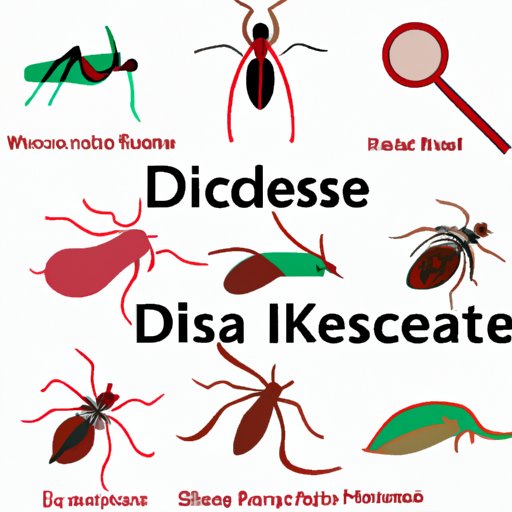
Introduction
When it comes to public health, few things are more important than understanding how diseases are transmitted from person to person. One of the key ways that diseases spread is through vectors, which are organisms that carry and transmit diseases. In this article, we will explore what is meant by the term “disease vector” and how vectors play a role in global public health.
Definition of a Disease Vector and Purpose of the Article
A disease vector is any organism that carries and transmits disease-causing pathogens. This can include insects, arachnids, and other animals. The purpose of this article is to explore the concept of disease vectors in more detail, including how they transmit disease and how they can be controlled to prevent the spread of illness.
Importance of Understanding Disease Vectors for Public Health
Understanding disease vectors is critical for public health officials and medical professionals alike. By identifying vectors and controlling their populations, we can prevent the spread of diseases that can have a devastating impact on both individuals and entire communities. Furthermore, as climate change continues to impact global weather patterns, the study of disease vectors has become even more important in preventing the emergence of new and dangerous diseases.
What is a Disease Vector?
Definition and Explanation of Disease Vectors
Disease vectors are any organisms that can carry and transmit disease-causing pathogens. These pathogens can include bacteria, viruses, and parasites, and they are often transmitted through bodily fluids or tissues such as blood or saliva. Vectors can be found in all parts of the world and can infect both humans and animals.
How Vectors Spread Diseases
Vectors spread diseases by carrying pathogens from one organism to another. This can happen in a variety of ways, including through physical contact, bites, and ingestion. For example, mosquitoes can transmit malaria by biting an infected person and then biting a healthy person, passing on the parasite that causes the disease.
Different Types of Vectors and the Health Problems They Can Cause
There are many different types of vectors, each of which can cause a range of health problems. Common vectors include mosquitoes, ticks, lice, fleas, and rodents. Mosquitoes are known to transmit diseases such as malaria and dengue fever, while ticks can carry Lyme disease. Lice are associated with typhus, and fleas are infamous for spreading the bubonic plague. Rodents can carry diseases such as hantavirus.
The Role of Disease Vectors in Public Health
Detrimental Impact of Vectors on Communities
Vectors can have a detrimental impact on entire communities, particularly in areas with limited access to medical care. When a population is affected by a vector-borne disease, it can lead to a range of health problems and economic hardships. This can include missed work days, increased healthcare costs, and reduced agricultural output due to worker illness or death.
Importance of Controlling Vectors as a Preventive Measure
Controlling vectors is an important preventive measure that can have a significant impact on public health. By reducing the number of vectors in a particular area, we can reduce the spread of diseases such as malaria, Lyme disease, and typhus. This approach is often more effective and cost-efficient than treating individuals for diseases after they have already been infected.
Examples of Vector-Borne Diseases in History
Vector-borne diseases have had a significant impact throughout history. Some of the most famous examples include the bubonic plague, which killed millions of people in Europe during the 14th century, and malaria, which has been a leading cause of death in tropical regions for centuries. More recently, outbreaks of diseases such as Zika virus and Ebola have raised awareness of the importance of understanding vectors and how they spread disease.
How to Identify and Control Disease Vectors
Simple Steps Homeowners Can Take
There are many simple steps that homeowners can take to control the population of disease vectors in their area. This may include using mosquito nets and insect repellent, sealing up cracks and crevices in homes to keep out rodents, and keeping your yard clean and free of standing water, which can attract mosquitoes.
Professional Methods Used by Public Health Officials
Public health officials often use a range of professional methods to control vectors and prevent the spread of disease. This includes using pesticides and insecticides to kill mosquitoes and other insects, as well as using traps to capture rodents. Public education campaigns can also help to raise awareness of the importance of vector control and prevention measures.
Importance of Ongoing Vector Control
Finally, it’s important to recognize that vector control is an ongoing process that requires attention and resources on an ongoing basis. Failing to control vectors can lead to the emergence of new diseases and the spread of existing diseases, which can have significant negative consequences on public health and economic well-being.
The Global Health Impact of Disease Vectors
Worldwide Effect of Vector-Borne Diseases
Vector-borne diseases have a significant impact on public health around the world. According to the World Health Organization (WHO), more than half of the world’s population is at risk of developing diseases such as malaria and dengue fever due to vector-borne transmission. These diseases can be particularly devastating in low-income countries with limited access to medical care.
Organizations, Such as the WHO, Working to Eradicate Vectors
Organizations such as the WHO are working to eradicate vectors and prevent the spread of vector-borne diseases. One of the most important steps in this process is to raise awareness of the importance of vector control and prevention measures. Research into new methods of vector control, such as the use of genetically modified mosquitoes, is also ongoing.
Examples of Success in Controlling Vector-Borne Diseases
There have been many successful efforts to control vector-borne diseases throughout history. For example, the use of bed nets coated in insecticide has been very effective in reducing the number of malaria cases in certain areas of Africa. Similarly, the use of DDT as a pesticide during World War II helped to reduce the number of cases of typhus and other vector-borne diseases.
Emerging and Reemerging Diseases Due to Vectors
Increase in Emerging and Reemerging Diseases
Unfortunately, despite our best efforts, there has been an increase in the number of emerging and reemerging diseases due to vectors in recent years. This may be due in part to the impact of climate change on vector migration patterns, which has led to the emergence of new and dangerous diseases in areas where they were previously unknown.
Importance of Awareness and Prevention
As we continue to face new and emerging vector-borne diseases, it is more important than ever to raise awareness of the importance of prevention measures. This may include using insect repellent, wearing protective clothing, and reducing exposure to vectors by avoiding areas where they are known to be present.
Examples of Recent Outbreaks
There have been a number of recent outbreaks of vector-borne diseases that have had a significant impact on public health. For example, the Zika virus outbreak in South America in 2015-2016 led to a range of health problems, including microcephaly in newborns and Guillain-Barre syndrome in adults. Similarly, the Ebola outbreak in West Africa in 2014-2016 led to more than 11,000 deaths.

The Link Between Climate Change and Disease Vectors
Climate Change and Changes in Vector Migration Patterns
There is growing evidence to suggest that climate change is having a significant impact on vector migration patterns. As weather patterns shift, we are seeing an increase in the number of vectors in certain areas, which can lead to the emergence of new diseases and the spread of existing ones.
Effects on Disease Transmission and Spread
Changing vector migration patterns can also impact the transmission and spread of existing diseases. For example, if a vector begins to move into a new area, it can bring with it diseases that were previously unknown in that area. Additionally, warmer temperatures and changing weather patterns can create conditions that are more conducive to disease transmission.
Potential Future Impact
As the impact of climate change continues to be felt around the world, it is likely that we will see an increasing number of vector-borne diseases. This makes it more important than ever to invest in vector control measures and prevention efforts, as well as to continue to monitor vector migration patterns and the emergence of new diseases.
An Overview of the Most Common Disease Vectors
Mosquitoes and Vector-Borne Diseases such as Malaria and Dengue Fever
Mosquitoes are one of the most common disease vectors and are responsible for transmitting a range of diseases, including malaria, dengue fever, and Zika virus. Mosquitoes breed in standing water, so reducing the amount of standing water around your home can help to reduce the number of mosquitoes in your area.
Ticks and Lyme Disease
Ticks are another common vector and can transmit diseases such as Lyme disease. Ticks are often found in wooded areas and can be carried into homes by pets. Wearing protective clothing and using insect repellent can help to reduce your risk of tick bites.
Lice and Typhus
Lice can carry the bacteria that causes typhus, a disease that can cause fever, headache, and muscle aches. Lice are often found in areas where hygiene is poor, such as refugee camps or areas with a high population density.
Fleas and Plague
Fleas are responsible for transmitting the bacteria that causes the bubonic plague, a disease that led to the deaths of millions of people in Europe during the 14th century. Fleas are often found on rodents, so reducing the number of rodents in your area can help to reduce the risk of flea bites.
Rodents and Hantavirus
Finally, rodents are another common vector and can carry diseases such as hantavirus. Rodents can be found in all parts of the world and can be attracted to homes and other buildings due to the availability of food, water, and shelter.
Conclusion
Summary of Main Points
Disease vectors are organisms that carry and transmit disease-causing pathogens. They can spread diseases in a variety of ways, including through bites, physical contact, and ingestion. Controlling vectors is an important preventive measure that can have a significant impact on public health. There have been many successful efforts to control vector-borne diseases throughout history, but there is still much work to be done in preventing the emergence of new diseases due to changing vector migration patterns.
Encouragement to Take Steps to Prevent Vector-Borne Diseases
By taking simple steps to control vector populations and prevent bites, we can all play a role in preventing the spread of vector-borne diseases. This may include using insect repellent, wearing protective clothing, and reducing exposure to vectors by avoiding areas where they are known to be present.
Final Thoughts on the Importance of Controlling Disease Vectors for Public Health
Controlling disease vectors is critical for ensuring the health and well-being of individuals and communities around the world. By investing in vector control measures and prevention efforts, we can reduce the spread of diseases that can have a significant negative impact on public health and economic well-being.





